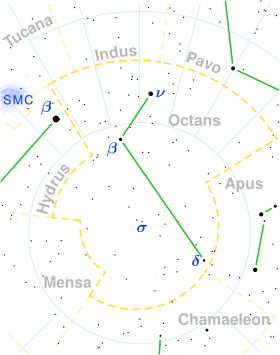Nu Octantis
| Observation data Epoch J2000 Equinox J2000 | |
|---|---|
| Constellation | Octans |
| Right ascension | 21h 41m 28.64977s[1] |
| Declination | −77° 23′ 24.1563″[1] |
| Apparent magnitude (V) | 3.73[2] |
| Characteristics | |
| Spectral type | K1III[3] |
| U−B color index | +0.89[4] |
| B−V color index | +1.00[4] |
| Astrometry | |
| Radial velocity (Rv) | +34.40[5] km/s |
| Proper motion (μ) | RA: +66.41[1] mas/yr Dec.: -239.10[1] mas/yr |
| Parallax (π) | 45.25 ± 0.25[6] mas |
| Distance | 72.1 ± 0.4 ly (22.1 ± 0.1 pc) |
| Absolute magnitude (MV) | 2.10[2] |
| Details | |
| Mass | 1.04[7] M☉ |
| Radius | 5.9[7] R☉ |
| Luminosity | 17.53[2] L☉ |
| Surface gravity (log g) | 2.92[7] cgs |
| Temperature | 4,831[8] K |
| Rotational velocity (v sin i) | < 1.0[9] km/s |
| Other designations | |
| Database references | |
| SIMBAD | data |
Nu Octantis is a spectroscopic binary[10] star in the constellation Octans with a period around 2.9 years.[6] Its apparent magnitude is 3.73.[2] Located around 21.20 parsecs (69.1 ly) distant,[1] the primary is an orange giant of spectral type K1III,[3] a star that has used up its core hydrogen and has expanded.
In 2009, the system was hypothesized to contain an exoplanet based on perturbations in the orbital period.[6] A prograde solution was quickly ruled out[11] but a retrograde solution remains a possibility, although the variations may instead be due to the secondary star being itself a close binary[12] and the formation of a planet in the system is difficult due to dynamic perturbations.[13]
References
- 1 2 3 4 5 Van Leeuwen, F. (2007). "Validation of the new Hipparcos reduction". Astronomy and Astrophysics. 474 (2): 653. arXiv:0708.1752
 . Bibcode:2007A&A...474..653V. doi:10.1051/0004-6361:20078357. Vizier catalog entry
. Bibcode:2007A&A...474..653V. doi:10.1051/0004-6361:20078357. Vizier catalog entry - 1 2 3 4 Anderson, E.; Francis, Ch. (2012). "XHIP: An extended hipparcos compilation". Astronomy Letters. 38 (5): 331. arXiv:1108.4971
 . Bibcode:2012AstL...38..331A. doi:10.1134/S1063773712050015. Vizier catalog entry
. Bibcode:2012AstL...38..331A. doi:10.1134/S1063773712050015. Vizier catalog entry - 1 2 Gray, R. O.; et al. (July 2006). "Contributions to the Nearby Stars (NStars) Project: spectroscopy of stars earlier than M0 within 40 pc-The Southern Sample". The Astronomical Journal. 132 (1): 161–170. arXiv:astro-ph/0603770
 . Bibcode:2006AJ....132..161G. doi:10.1086/504637.
. Bibcode:2006AJ....132..161G. doi:10.1086/504637. - 1 2 Mallama, A. (2014). "Sloan Magnitudes for the Brightest Stars". The Journal of the American Association of Variable Star Observers. 42: 443. Bibcode:2014JAVSO..42..443M.Vizier catalog entry
- ↑ Wilson, R. E. (1953). General Catalogue of Stellar Radial Velocities. Carnegie Institution for Science. Bibcode:1953GCRV..C......0W. LCCN 54001336.
- 1 2 3 Ramm, D. J.; Pourbaix, D.; Hearnshaw, J. B.; Komonjinda, S. (April 2009). "Spectroscopic orbits for K giants β Reticuli and ν Octantis: what is causing a low-amplitude radial velocity resonant perturbation in ν Oct?". Monthly Notices of the Royal Astronomical Society. 394 (3): 1695–1710. Bibcode:2009MNRAS.394.1695R. doi:10.1111/j.1365-2966.2009.14459.x.
- 1 2 3 Allende Prieto, C.; Lambert, D. L. (1999). "Fundamental parameters of nearby stars from the comparison with evolutionary calculations: Masses, radii and effective temperatures". Astronomy and Astrophysics. 352: 555. arXiv:astro-ph/9911002
 . Bibcode:1999A&A...352..555A. Vizier catalog entry
. Bibcode:1999A&A...352..555A. Vizier catalog entry - ↑ Martínez, M. Isabel Pérez; Schröder, K.-P.; Cuntz, M. (2011). "The basal chromospheric Mg ii h+k flux of evolved stars: Probing the energy dissipation of giant chromospheres". Monthly Notices of the Royal Astronomical Society. 414: 418. arXiv:1102.4832
 . Bibcode:2011MNRAS.414..418P. doi:10.1111/j.1365-2966.2011.18421.x. Vizier catalog entry
. Bibcode:2011MNRAS.414..418P. doi:10.1111/j.1365-2966.2011.18421.x. Vizier catalog entry - ↑ De Medeiros, J. R.; Alves, S.; Udry, S.; Andersen, J.; Nordström, B.; Mayor, M. (2014). "A catalog of rotational and radial velocities for evolved stars". Astronomy & Astrophysics. 561: A126. arXiv:1312.3474
 . Bibcode:2014A&A...561A.126D. doi:10.1051/0004-6361/201220762. Vizier catalog entry
. Bibcode:2014A&A...561A.126D. doi:10.1051/0004-6361/201220762. Vizier catalog entry - ↑ Eggleton, P. P.; Tokovinin, A. A. (September 2008). "A catalogue of multiplicity among bright stellar systems". Monthly Notices of the Royal Astronomical Society. 389 (2): 869–879. arXiv:0806.2878
 . Bibcode:2008MNRAS.389..869E. doi:10.1111/j.1365-2966.2008.13596.x.
. Bibcode:2008MNRAS.389..869E. doi:10.1111/j.1365-2966.2008.13596.x. - ↑ Eberle, J.; Cuntz, M. (October 2010). "On the reality of the suggested planet in the ν Octantis system". The Astrophysical Journal. 721 (2): L168–L171. Bibcode:2010ApJ...721L.168E. doi:10.1088/2041-8205/721/2/L168.
- ↑ Morais, M. H. M.; Correia, A. C. M. (February 2012). "Precession due to a close binary system: an alternative explanation for ν-Octantis?". Monthly Notices of the Royal Astronomical Society. 419 (4): 3447–3456. arXiv:1110.3176
 . Bibcode:2012MNRAS.419.3447M. doi:10.1111/j.1365-2966.2011.19986.x.
. Bibcode:2012MNRAS.419.3447M. doi:10.1111/j.1365-2966.2011.19986.x. - ↑ Gozdziewski, K.; Slonina, M.; Migaszewski, C.; Rozenkiewicz, A. (March 2013). "Testing a hypothesis of the ν Octantis planetary system". Monthly Notices of the Royal Astronomical Society. 430 (1): 533–545. arXiv:1205.1341
 . Bibcode:2013MNRAS.430..533G. doi:10.1093/mnras/sts652.
. Bibcode:2013MNRAS.430..533G. doi:10.1093/mnras/sts652.
This article is issued from Wikipedia - version of the 11/30/2016. The text is available under the Creative Commons Attribution/Share Alike but additional terms may apply for the media files.
